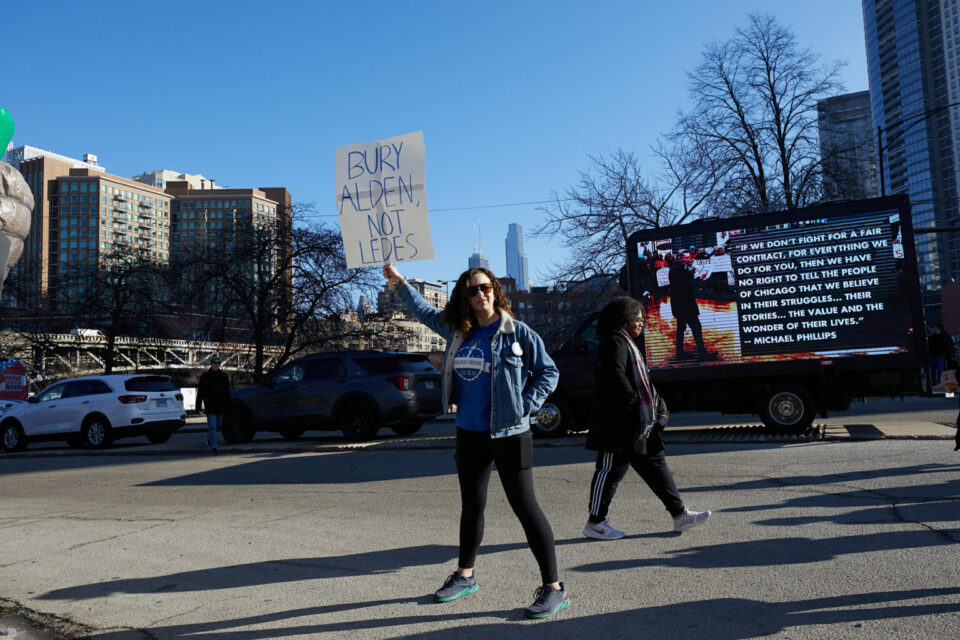No Gannett, McClatchy, Tribune Co. Partnerships
Progressives Include Human Rights in Cuba Agenda
. . . Tribute From Imprisoned Cuban Journalist
N.Y. Times Investigating Newsroom Leak
In One’s 80s, ‘It’s About Values and Real Abilities’
Ohio U. Pauses Scholarships That Mention Race
Poll Shows Blacks Support Menthol Cigarette Ban
Ferguson Citizens Win $4.5M Over ‘Debtors’ Prison’
NABJ Says ‘Colored’ Term Is Racist
Charles Ferris Dies, ‘G.O.A.T. of Media Diversity’
In Africa, Gaps Persist in Freedom of Information
Short Takes: Tavis Smiley; Catherine Kim; meteorologist David Tillman; Cassandra Singfield; publishing world diversity; Spokane’s Black newspaper; why not start a writer’s workshop?; “drill rap” as journalism; higher journalist jailings in Senegal; journalist assault in Democratic Republic of Congo; French journalist release in Ethiopia; incorporating video in Latin American newspapers.
Homepage photo: Strikers at the Chicago Tribune on Feb. 2. (Credit: News Guild)
Support Journal-isms
No Gannett, McClatchy, Tribune Co. Partnerships
- More on this Journal-isms Roundtable: Take Control, Journalists! But How?
By Isaiah Jerome Lewis Poole
Report for America, which has sent hundreds of journalists to buttress shrinking newsrooms, is phasing out its relationships with hedge fund-owned properties — a reviled group that includes some of the country’s largest newspaper companies.
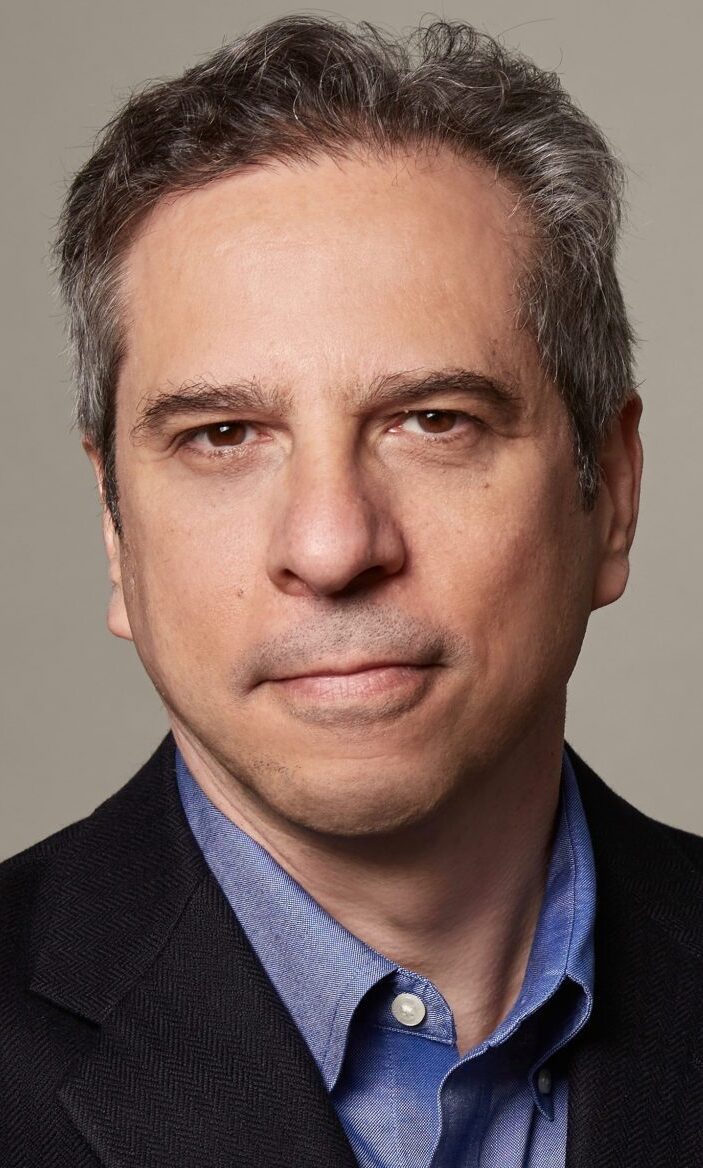 The pullout is the culmination of a two-year estrangement with the McClatchy Co., which severed its relationship with Report for America over critical comments by Steven Waldman (pictured), the project’s co-founder and former president.
The pullout is the culmination of a two-year estrangement with the McClatchy Co., which severed its relationship with Report for America over critical comments by Steven Waldman (pictured), the project’s co-founder and former president.
Kim Kleman (pictured below), executive director of Report for America, confirmed the decision during comments at a Journal-isms Roundtable on the state of the news industry (video) on Feb. 27, and in a follow-up email exchange.
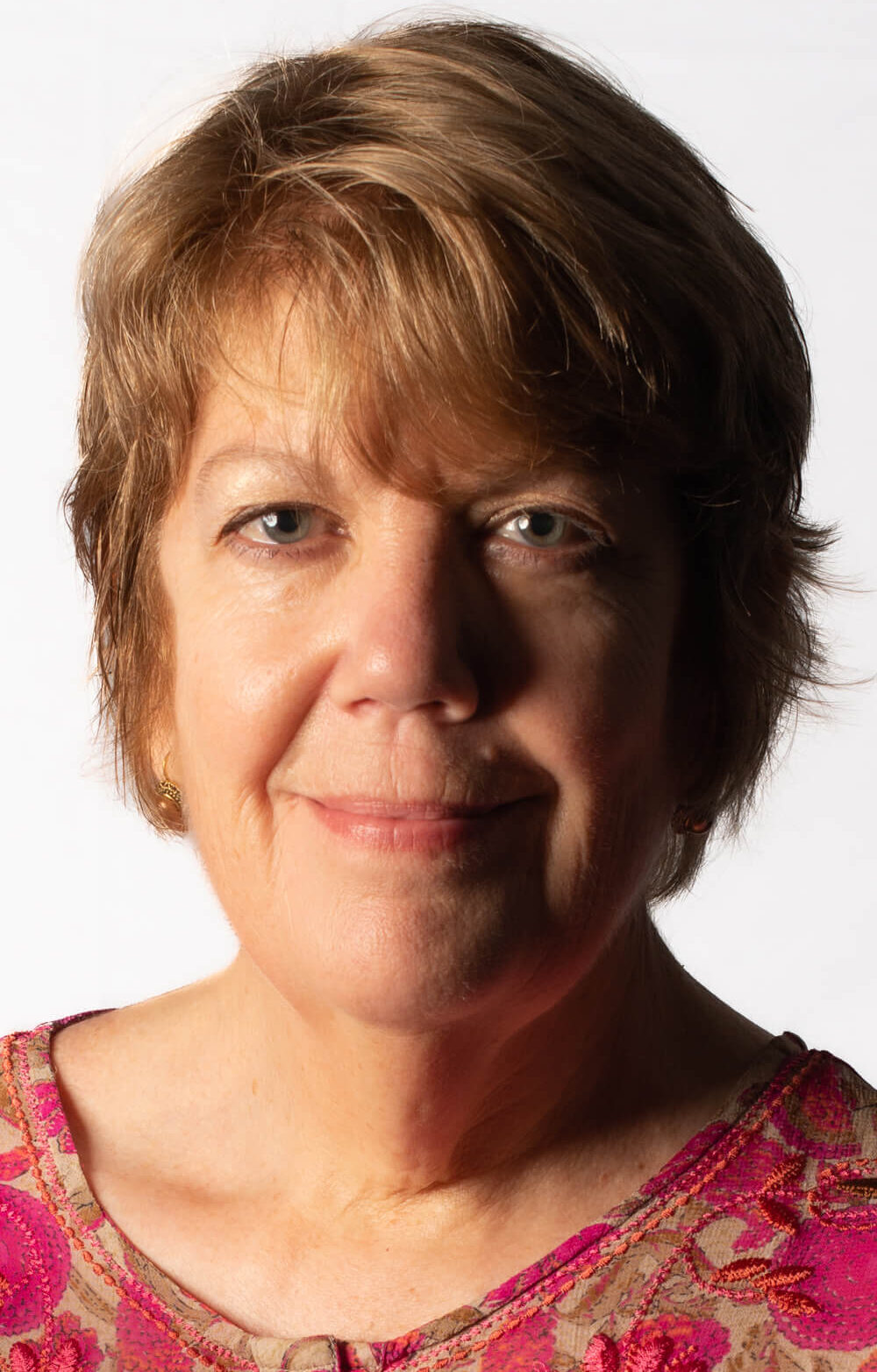 Report for America is a project of the nonprofit media organization The GroundTruth Project. Since its founding in 2017, it has recruited and supported more than 600 journalists, nearly half of whom are people of color, to work in 338 newsrooms. Kleman said its current cohort includes reporters in 198 partner news organizations. Of those, 11 are part of the now hedge fund-owned Gannett chain, the largest in the country, and one McClatchy newspaper.
Report for America is a project of the nonprofit media organization The GroundTruth Project. Since its founding in 2017, it has recruited and supported more than 600 journalists, nearly half of whom are people of color, to work in 338 newsrooms. Kleman said its current cohort includes reporters in 198 partner news organizations. Of those, 11 are part of the now hedge fund-owned Gannett chain, the largest in the country, and one McClatchy newspaper.
“We’ll continue with those until the corps members graduate,” Kleman said. No Tribune Co.-owned newspapers, also hedge-fund owned, are in the current cohort, Kleman said, and presumably won’t be eligible to participate as partners.
Some 200 News Guild members at Tribune Co. papers staged a 24-hour walkout on Feb. 1 and said of the papers’ owner, Alden Global Capital, “The hedge fund has been slammed for decimating the newsrooms it has acquired and strip-mining its media assets for profits. Papers owned by Alden have cut staff at twice the rate of their competitors, and circulation has fallen faster at their papers than at their [peers’.]”
Kleman said at the Roundtable, “We started at Report for America working with what are now hedge fund-owned organizations because we considered ourselves as supporting communities and sometimes those newsrooms owned by those companies were the only game in town.”
But the relationships began to sour when, in 2021, Waldman wrote an op-ed in the Los Angeles Times that declared the hedge-fund takeover of newspapers representing half of the country’s total newspaper circulation to be “a real threat to democracy” and said, “we need to confront it head on, including with public policies.”
A few months later, Columbia Journalism Review reported that McClatchy, which at the time had 31 Report for America journalists working at 21 of its publications, told Report for America that it was pulling out of the partnership. “Sources tell CJR that McClatchy’s decision came in response to Waldman’s hedge-fund criticism. Kristin Roberts, McClatchy’s senior vice president of news, would not confirm the company’s plans, and did not respond to questions concerning the company’s reaction to Waldman’s hedge-fund critiques.”
Kleman messaged that she remains proud of the work that Report for America has done with Gannett and McClatchy “and we continue to root for those newsrooms.”
She added, however, that more recently “we’re seeing all kinds of newsrooms with various business models emerge and succeed. When we partner with host newsrooms, we’re making a big bet on them — that with our help, they’ll become more sustainable, and can become beacons for other newsrooms that can learn from their challenges, new ideas and successes.

“The recent history of hedge-fund ownership, where a focus on profits has often decimated newsrooms, suggests that business model isn’t the future for robust local news,” Kleman continued.
Spokespeople for McClatchy and Gannett did not respond to requests for comment.
Private-equity takeovers of newspapers, and the concentration of ownership that has resulted, has been the most significant contributor to the layoffs and decline in local news reporting in the industry, numerous studies confirm.
An extensive 2023 study by professors Michael Ewens of Columbia Business School and Arpit Gupta and Sabrina T. Howell of New York University found that newspapers owned by private equity firms reduced their staffs on average more deeply than their peers, resulting particularly in a loss of local news coverage that demonstrably affected local political engagement.
“Behind newspaper chain names like Gannett, Digital First Media, and McClatchy are wealthy hedge fund managers calling the financial shots as newspapers nationwide wither on the vine,” wrote Margot Susca in her just-released book “Hedged: How Private Investment Funds Helped Destroy American Newspapers and Undermine Democracy.”
She describes how these newspaper ownership groups operate as “overharvesting,” comparable to a farmer overworking and undernourishing land. “How debt accumulated in the wake of disastrous mergers and acquisitions, why reporters were laid off, and how audiences stopped seeing value in their daily newspapers are tied to profit and the sometimes absurd decision-making of newspaper company executives to maximize it.”
Since Report for America’s founding, there has always been more demand from newsrooms than the organization had resources to meet, Kleman said. “In our new cohort, which begins in July, we’re adding 55 new positions, for a total of 200 positions, including continuing corps members. Yet we got hundreds more applications from newsrooms than we could support. So we have to be very, very choosy, working with newsrooms we believe are committed to investing in their journalism and their communities.”
- Jeremy Barr, Washington Post: A top pipeline for local journalists is saying no to hedge funds (March 5, updated March 6)
- Sophie Culpepper, NiemanLab: Report for America is “phasing out” partnerships with hedge fund-owned publications (March 4)
- Kim Kleman, Poynter Institute: Why Report for America will no longer place corps members in hedge fund-owned publications (March 7)

Progressives Include Human Rights in Cuba Agenda
“A delegation of the U.S. Congressional Progressive Caucus traveled to Cuba last week in a trip that has not previously been disclosed by the legislators nor reported in Cuban state media,” Nora Gámez Torres reported Tuesday for the Miami Herald.
Democratic U.S. Reps. Pramila Jayapal of the state of Washington and Ilhan Omar of Minnesota “traveled to Cuba last week, where they met with people from across Cuban civil society and government officials to discuss human rights and the U.S.-Cuba bilateral relationship,” said a spokesperson for the Congressional Progressive Caucus.
“Human rights” generally includes press freedom, though the spokesperson could not be reached to confirm that.
Matt Berg and Eric Bazail-Eimil reported Friday for Politico that the two members of Congress “visited Havana to meet with Cuban officials, including President Miguel Diaz-Canel, as part of an effort to mend ties with Washington. They also met with relatives of those imprisoned for protesting against the government.”
In its 2023 World Report, Human Rights Watch wrote, “Cuba was holding over 1,020 people who met the definition of political prisoners as of September, Prisoners Defenders, a Madrid-based organization said. These included 235 under house arrest or on conditional release.
“Cubans who criticize the government risk prosecution. They are not guaranteed due process or a fair trial by a competent, independent, and impartial tribunal. In practice, courts are subordinate to the executive branch.”
When the Committee to Protect Journalists in 2022 awarded Abraham Jiménez Enoa its International Press Freedom Award, he told of how he was forced to flee Cuba for Spain and dedicated his award to two other independent journalists now in Cuban prisons. The wife of one, Lázaro Valle Roca, fears for the state of his health.
Iván García wrote Jan. 28 for Diario Las Americas, “Opposition activist Eralidis Frómeta fears for her husband’s life. She told Diario Las Américas that last Monday the 22nd was the visit of Lázaro Yuri Valle Roca, 62 years old, to the Combinado del Este maximum security prison, located just over 15 kilometers from the center of Havana.
“ ‘It just so happened that Yuri’s father, a resident of the United States, was in Cuba and went to the prison with me. They put him and his brother in a prison office for almost two hours with political police agents. I was not allowed to be present. Later they let me enter. At that moment the agents went out, according to them, to look for Yuri in his cell. After half an hour, Lieutenant Colonel Pedro, from State Security, returned to tell us that we would only be able to speak with Yuri by phone.’ ”
The Miami Herald’s Gámez Torres also wrote, “Cuban official media traditionally highlight American lawmakers going to the island, usually framing their visit as a gesture of ‘solidarity’ with the Cuban people or support for ending the U.S. embargo. This time, state media was mum. Cuba’s Foreign Ministry did not disclose the trip . . . .”
She also reported, “Last week, Kerri Hannan, deputy assistant secretary for Public Diplomacy, Policy, Planning and Coordination at the State Department, met with members of Cuba’s civil society, Black activists, human rights defenders and independent private entrepreneurs, the U.S. embassy in Havana said in a statement. She also met with Cuban government officials ‘and pressed for the release of political prisoners,’ the embassy said.”
A State Department spokesperson messaged Journal-isms Friday, “Our diplomats both in Washington and the U.S. Embassy in Havana regularly meet with Cubans from all walks of life.
“Due to privacy considerations, we do not name the individuals we meet with but do convene discussions that advance U.S. priorities, to include human rights, and equality. “
Indeed, Gamez Torres reported, “Despite the diplomatic tensions between the two countries, Cuban and American officials regularly meet to discuss migration and other national-security issues. Cuban officials traveled to Washington earlier this month to attend a law-enforcement dialogue with Department of Justice and Homeland Security officials.”
. . . Tribute From Imprisoned Cuban Journalist
Posted on Facebook, Feb. 23 (a rough translation)
By Jorge Bello Domínguez (pictured), “independent Cuban journalist and current Political Prisoner in the maximum security prison ‘Combinado del Este,’ Havana.”
 Coming up on 14 years since the death of the martyr for freedom and democracy in Cuba. ¨Orlando Zapata Tamayo¨, this February 23, I take this opportunity to pay a simple but well-deserved tribute to those who do not cease nor give in before his executioners.
Coming up on 14 years since the death of the martyr for freedom and democracy in Cuba. ¨Orlando Zapata Tamayo¨, this February 23, I take this opportunity to pay a simple but well-deserved tribute to those who do not cease nor give in before his executioners.
“Who endured countless beatings in all the prisons in which he was confined. Orlando Zapata was initially [sentenced] to three years in prison for denouncing the violations of Human Rights, for daring to speak publicly for the [legal reform] Project Varela in the Central Park of Havana.
“He was not a terrorist, nor conspirator, he did not use violence either, but he received ruthless treatment from
a cruel, murderous and inhuman regime commanded by the Castro brothers Ruz.
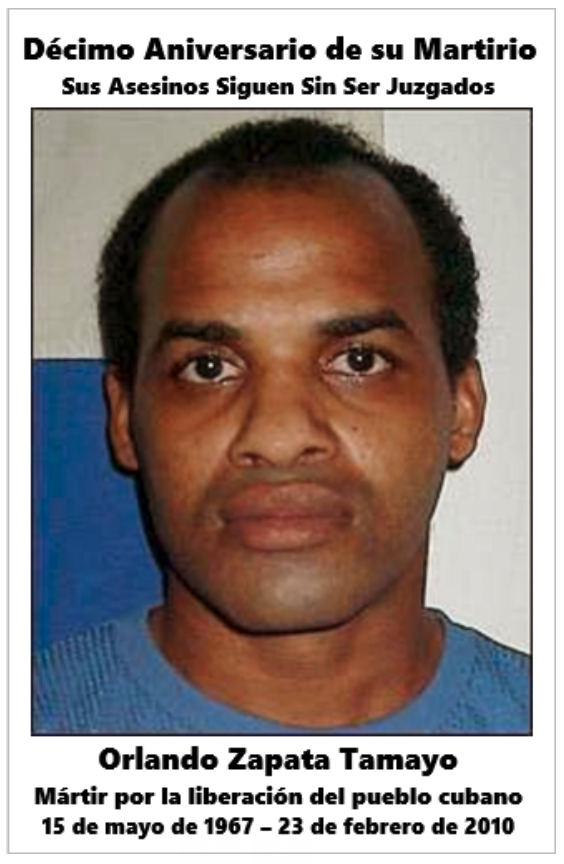 “Zapata (pictured) died that afternoon of February 23, 2010, after suffering many insults, racist contempt, beatings and all kinds of abuse of their jailers complying with strict orders from State Security, was killed slowly over many days, months.
“Zapata (pictured) died that afternoon of February 23, 2010, after suffering many insults, racist contempt, beatings and all kinds of abuse of their jailers complying with strict orders from State Security, was killed slowly over many days, months.
“[He started his] last hunger strike on December 3 in the dark mission of Kilo 8 in Camagüey, where he had been transferred from prison Holguín province, being savagely beaten by hitmen Castro before the transfer.
“Zapata Tamayo only demanded more dignified and humane treatment for him and his fellow political prisoners, as is usual, received in response from the Cuban government the arrogance, the contempt that is part of the crime, yes, a hate crime.
“Orlando Zapata Tamayo, a simple man from the town since in case he was a hero, he gave himself, until he died, for freedom, dignity and rights of all Cubans. And what can we say about the courts that immorally condemned instead of having the decency to defend a man who suffered.”
- Freedom House: Freedom in the World 2024 – Cuba
- Alexander Mallin, ABC News: Former US ambassador accused of spying for Cuba for decades to plead guilty
- Andrew Solender, Axios: Top House progressives make under-the-radar visit to Cuba
- Filip Timotija, the Hill: Progressive Democrats travel to Cuba
- Washington Times: Ilhan Omar, Pramila Jayapal make secret trip to Cuba, drawing outrage from Republicans

N.Y. Times Investigating Newsroom Leak
The New York Times is conducting a leak investigation following a report in The Intercept about a yet-to-be-aired episode of The Daily addressing explosive claims of sexual violence committed by Hamas on October 7,” Charlotte Klein reported Thursday for Vanity Fair.
“Management in recent weeks has pulled at least two dozen staffers, including Daily producers, into meetings in an attempt to understand how internal details about the podcast’s editorial process got out, according to multiple sources familiar with the matter. The investigation, I’m told, is being led by Charlotte Behrendt, the paper’s director of policy and internal investigations.
“In late January, The Intercept reported that the Times had planned to air an episode of The Daily weeks earlier that was based on a December Times investigation, led by Pulitzer Prize-winner Jeffrey Gettleman and coauthored by freelancers Anat Schwartz and Adam Sella, about how Hamas ‘weaponized sexual violence’ in the October attack on Israel. But the paper shelved that episode ‘amid a furious internal debate about the strength of the paper’s original reporting on the subject,’ according to The Intercept. . . . “
Meanwhile, the Committee to Protect Journalists reported, “As of March 2, 2024, CPJ’s preliminary investigations showed at least 94 journalists and media workers were among the more than 30,000 killed since the war began on October 7 — with more than 30,000 Palestinian deaths in Gaza and the West Bank and 1,200 deaths in Israel. . . .”
- International Federation of Journalists: Palestine: IFJ nominates Palestinian Journalists’ Syndicate for global press freedom prize
- Laura Wagner, Washington Post: New York Times accused of racial targeting in leak hunt over Israel stories
In One’s 80s, ‘It’s About Values and Real Abilities’
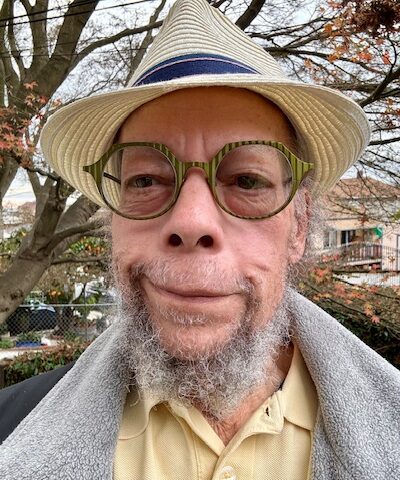 Amid the discussion of the ages of President Biden, 81, and former President Donald Trump, 77, as they likely face each other in November, Journal-isms asked journalists of color in their 80s what they thought about all the talk about age, and what we can tell journalists about what it’s like to be in one’s 80s, especially as they write about the topic. They were asked to keep the comments to 50 words or less.
Amid the discussion of the ages of President Biden, 81, and former President Donald Trump, 77, as they likely face each other in November, Journal-isms asked journalists of color in their 80s what they thought about all the talk about age, and what we can tell journalists about what it’s like to be in one’s 80s, especially as they write about the topic. They were asked to keep the comments to 50 words or less.
First to respond was Austin Long-Scott, (pictured) a member of the Hall of Fame of the National Association of Black Journalists who has taught at San Francisco State University and written for the Associated Press and Washington Post:
“Really . . . only 50 words for 85 years?” Long-Scott replied.
“The thing about being old is by the time you get there it’s almost all individual, so you need to be judged by your abilities, not your age. But Americans would rather stereotype.
“My mother was active and engaged into her 90s and lived almost to 101. I’m 85 and slowing down, but I still drive and walk without aids. A huge number of the people I met in 50 years in journalism are no longer alive.
“Yet as the first black full-time AP journalist, it’s wonderful to see the symphony of color in journalism now. With Biden vs Trump it’s about values and real abilities, not stereotypes and lies. But these days you may not be able to rely on journalism to inform you of those things.”
- Peter Baker, New York Times: Biden Tries to Turn the Tables on Trump: ‘He’s About as Old as I Am’

Ohio U. Pauses Scholarships That Mention Race
Over the objections of the dean of the journalism school, Ohio University has paused awarding scholarships for which race may be a criteria in response to a U.S. Supreme Court decision last year, David Forster reported Feb. 23 for WOUB, which considers itself an “experiential-learning unit of Ohio University’s Scripps College of Communication.”
“The pause applies not only to scholarships that reference race but may also include those that reference gender or sexual orientation.
“ ‘In light of the Supreme Court ruling, we need to evaluate a small but important subset of gift agreements that reference protected classes to ensure they can be awarded lawfully,’ Robin Oliver, the university’s vice president of communications and marketing, said in a written response to WOUB. ‘That review of language is in progress.’ . . .
“It’s unclear at this point how many scholarships will be affected by this decision.
 “Eddith Dashiell (pictured), director of the university’s journalism school, heard about the university’s decision to put a hold on certain scholarships two weeks ago in a meeting with the school’s dean, Scott Titsworth.
“Eddith Dashiell (pictured), director of the university’s journalism school, heard about the university’s decision to put a hold on certain scholarships two weeks ago in a meeting with the school’s dean, Scott Titsworth.
“She later wrote a letter to the dean opposing the decision, and this letter was posted by an anonymous user on the social media site reddit the day before the university issued its public statement.
“ ‘I sat in shock and disappointment during the Scripps College Dean’s directors meeting on February 8, 2024, when you shared with the directors the directive you and the other deans received that we will not be allowed to award any of our 2024-25 diversity scholarships from outside donors based on the Ohio attorney general’s interpretation of the U.S. Supreme Court’s decision in Students for Fair Admission v. Harvard.’
“In its decision last June [PDF] ,the Supreme Court said that race could not be used as a factor in admissions decisions. The decision did not address scholarships.
“A day later, Ohio Attorney General Dave Yost issued a memo to the state’s universities and colleges in which he wrote that ‘institutions of higher education and institutional employees must immediately cease considering race when making admissions decisions.’
“Forster wrote that Dashiell suspects there are several journalism scholarships that total many thousands of dollars that will not make the list.
“These include scholarships from the Scripps Howard Fund that are intended to promote diversity and inclusion in the media.”
- Curt Anderson, Associated Press: U of Florida axes diversity and inclusion office under GOP-led law aimed at ridding similar programs
- Kayla Beard, Athens (Ohio) News: Black journalism professor recalls some rough times at OU (March 18, 2018)

Poll Shows Blacks Support Menthol Cigarette Ban
“A poll released earlier this month on behalf of the Campaign for Tobacco-Free Kids shows that support of a ban on menthol cigarettes is stronger among Black voters than the electorate as a whole,“ Margo Snipe reported Thursday for Capital B. “It pushes back against a poll commissioned by tobacco giant Altria late last year, which said such a ban would sway voters away from [President] Biden in the upcoming election.”
“As the White House considers the FDA’s final rule prohibiting the sale of menthol cigarettes, a new poll shows that voters support the rule by a substantial 29-point margin (58% to 29%) and Black voters support it by an even larger 37-point margin (62% to 25%),” the Campaign announced Feb. 22.
“Contrary to claims made by the tobacco industry, implementation of the rule would not harm President Biden’s electoral prospects, with no change in Biden’s overall standing after voters were asked to assume that the Biden Administration ended the sale of menthol cigarettes, the poll shows. . . .
“To test the menthol rule’s potential electoral impact, the poll asked an initial presidential horse-race question between President Biden and former President Donald Trump, which gave Biden a two-point lead over Trump, 44% to 42%. Then, after introducing the proposed FDA menthol rule, the poll re-asked the horse-race question, prefacing the question with, ‘If the Biden Administration ended the sale of menthol flavored cigarettes in the United States…’ Assuming the Biden Administration ended menthol cigarette sales produced no change in the margin, with Biden maintaining a two-point lead (45% to 43%). . . .”
“This new data proves what we already know to be true – Black voters want to see a menthol ban,” national NAACP President and CEO Derrick Johnson said in a statement. “Now, it’s time for the Biden Administration to put people over profits and swiftly enact a rule that will save countless Black lives. We’re done waiting. … Our lives are at stake.”
The National Newspaper Publishers Association, representing Black-press publishers, has opposed the ban, denying that its stance is influenced by the thousands of dollars it has received from the tobacco industry.
NNPA’s news service reported, “On December 9, Dr. Benjamin Chavis, President and CEO of the National Newspaper Publishers Association, told Victor Blackwell, Anchor and Correspondent of CNN, ‘The ban will have negative consequences in the Black community. From my long years as a civil rights activist, I’m against all forms of racial profiling and racial targeting. Bans do not work. We are calling for a Racial Impact Study. The FDA did not study the racial consequences of this new proposal. We want to save lives in the Black community from disproportionate health, but we also want to save lives from police brutality. We don’t want another Eric Garner…‘ ”
- Centers for Disease Control and Prevention: Tips From Former Smokers — African American People
- Renee Graham, Boston Globe: https://www.bostonglobe.com/2024/01/27/opinion/renee-graham-conservatives-target-biden-menthol-cigarettes-ban/?p1=StaffPage (Jan. 27)
- Yuki Noguchi, NPR: The fight over banning menthol cigarettes has a long history steeped in race (Feb. 1)
- Clarence Page: Chicago Tribune: A ban on menthol cigarettes? It’s about time (April 29, 2022)
- Ben Stockton, The Bureau of Investigative Journalism: Detroit pastor says he was offered $250,000 to oppose menthol cigarette ban (Aug. 25, 2022)

Ferguson Citizens Win $4.5M Over ‘Debtors’ Prison’
Ferguson, Mo., the St. Louis suburb where Michael Brown was fatally shot by a police officer, “has agreed to pay $4.5 million to settle a class-action lawsuit that accused it of operating a so-called debtors’ prison,” Jim Salter reported Tuesday for the Associated Press. The “debtors’ prison” came to public attention through media reports and a Justice Department report after the uprisings that followed Brown’s shooting.
“The legal nonprofit ArchCity Defenders announced the settlement Tuesday with the city of Ferguson, Missouri,” Salter continued. “The preliminary agreement calls for the money to be paid out to more than 15,000 people who were jailed between Feb. 8, 2010, and Dec. 30, 2022, for failing to pay fines, fees and other court costs.
“Michael Brown, 18, was fatally shot by white Ferguson police officer Darren Wilson on Aug. 9, 2014, during a street confrontation. Wilson was not charged, but the shooting led to months of protests and prompted a Department of Justice investigation. . . .”
The “debtors’ prison” practice did not take place only in Ferguson. In the city of St. Ann, another St. Louis-area municipality, more than 35,000 people will be eligible to receive a portion of a $3.125 million settlement preliminarily approved in federal court to resolve two class-action lawsuits over jail practices, the St. Louis Post-Dispatch reported in October.
In 2015, Tony Messenger and Kevin Horrigan of St. Louis Post-Dispatch were finalists for the Pulitzer Prize for editorial writing. “Of all the societal issues that have bubbled up as a result of Ferguson’s summer of unrest — including racial strife, underfunded schools, divided government, police brutality and hostility — the one that might be easiest to fix is a municipal court system that treats traffic fines as an ATM for city treasuries and a clique of lawyers. Fixing the municipal courts could have a wide-ranging positive effect on other issues,” one editorial said.
In 2021, Messenger wrote a book about the practices, “Profit and Punishment: How America Criminalizes the Poor in the Name of Justice.”
A 2017 headline in the Nation read, “The Justice Department’s report on Ferguson, Missouri, which revealed a system geared more toward gouging residents than public safety, opened the eyes of many to what is going on. But most people still don’t appreciate that Ferguson is everywhere in America today.”
Wesley Lowery said in 2015 after covering the Ferguson story for the Washington Post, “when we drop into a story like this, we now understand more broadly that it is not just to tell the story of this guy but also the coverage of specific interactions and the lack of relationship and the feeling of anger and abuse in the community.”
- Radley Balko, Washington Post: How municipalities in St. Louis County, Mo., profit from poverty (Sept. 3, 2014)
- Editorial, Washington Post: The DOJ takes on outrageous court fees that trap the poor (May 3, 2023)
- Journal-isms: A $15,000 Bill for Stealing $8 in Mascara (Dec. 31, 2021)
- Evan Perez, CNN: Justice report finds systematic discrimination against African-Americans in Ferguson (March 4, 2015)
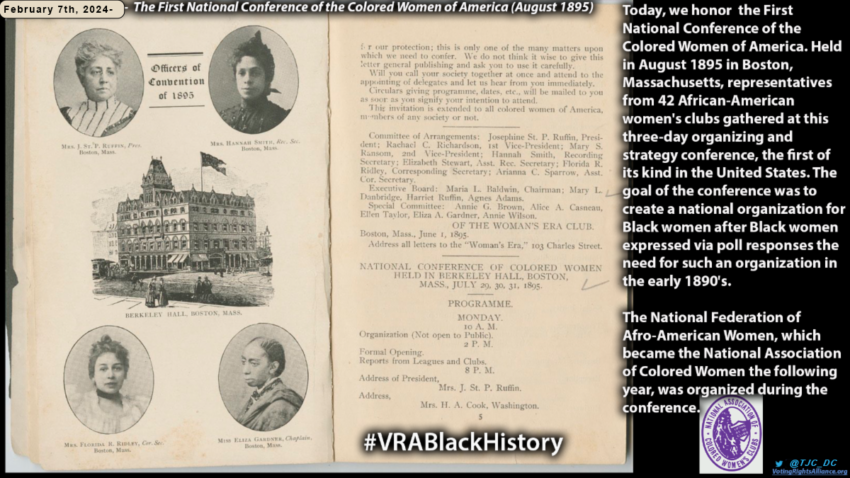
NABJ Says ‘Colored’ Term Is Racist
The National Association of Black Journalists said Friday it “is appalled and disappointed by a recent incident at KMOV, Gray Television’s affiliate in St. Louis. While teasing a story about Black homeowners and appraisals, an anchor referred to the homeowners as ‘colored.’ ”
NABJ called the term not only outdated and offensive, but “racist.”
While most agree that the word is outdated and can be taken as a slur, the National Association for the Advancement of Colored People would not consider itself a racist organization.
Columnist William Safire, the late New York Times language maven (who is white), wrote in 1988, “According to James Williams, an N.A.A.C.P. spokesman, who must get asked this often: ‘Times change and terms change. Racial designations go through phases; at one time ‘Negro’ was accepted, at an earlier time ‘colored’ and so on. This organization has been in existence for 80 years and the initials N.A.A.C.P. are part of the American vocabulary, firmly embedded in the national consciousness, and we feel it would not be to our benefit to change our name.”
Chicago Tribune columnist Clarence Page has marveled in print that he has “lived long enough to see us go from ‘colored people’ to ‘people of color.’ Progress!“
And Ntozake Shange’s 1974 choreopoem, “For Colored Girls Who Have Considered Suicide/When the Rainbow Is Enuf” has been revived on Broadway as recently as 2022.
The Associated Press Style book says, “Use Negro or colored only in names of organizations or in rare quotations when essential.”
NABJ also said, “While we understand that there have been multiple on-air apologies and KMOV management has met with local leaders, that is not enough. KMOV and Gray TV should retrain their employees on diversity, equity and inclusion issues while investing in recruiting and retaining Black employees on and off-air.
“Management at KMOV has reached out to NABJ to learn how to educate the newsroom on issues within the Black community. . . .”
- Donna Brazile, Yolanda Caraway, Leah Daughtry and Minyon Moore with Veronica Chambers, Macmillan Publishers: For Colored Girls Who Have Considered Politics (2019)
- Journal-isms: ‘African American’ Plus 20 (June 25, 2004)
- Kee Malesky, NPR: The Journey From ‘Colored’ To ‘Minorities’ To ‘People Of Color’ (March 30, 2014)
Charles Ferris advocates for the “Fairness Doctrine” in a March 18, 1987, congressional hearing. The doctrine mandated that broadcast networks devote time to contrasting views on issues of public importance and was in effect from 1954 to 1987. (Credit: YouTube)
Charles Ferris Dies, ‘G.O.A.T. of Media Diversity’
Charles D. Ferris, a Washington lawyer who helped enact landmark civil rights legislation as a top aide to Senate Majority Leader Mike Mansfield and who, said the Multicultural Media Telecom and Internet Council, known as MMTC, “probably set a record for the number of minority media and telecom lawyers he recruited, trained, and mentored“ [PDF], died Feb. 16 at his home in Chevy Chase, Md. He was 90.
“His daughter Caroline Ferris confirmed the death but did not cite a specific cause,” Harrison Smith reported Monday for the Washington Post.
MMTC, which advocates for broadcast ownership for people of color and helps train potential owners, also said of Ferris, chairman of the Federal Communications Commission, “Charlie was the G.O.A.T. of media diversity, having shepherded the Tax Certificate Policy through to unanimous adoption in 1978. The policy conferred a modest capital gain tax deferral on broadcasters and cablecasters who sold properties to minority entrepreneurs. The Tax Certificate Policy was by far the most impactful diversity policy ever adopted by the FCC.
“Charlie personally called the three major broadcast networks and the National Association of Broadcasters to secure their endorsements. The Policy quintupled minority broadcast ownership during its time in effect, 1978 – 1995. Charlie was a vigorous enforcer of the FCC’s EEO rules as well. As FCC Chairman from 1977-1981, minority employment in broadcasting grew by over 20%. . . .”
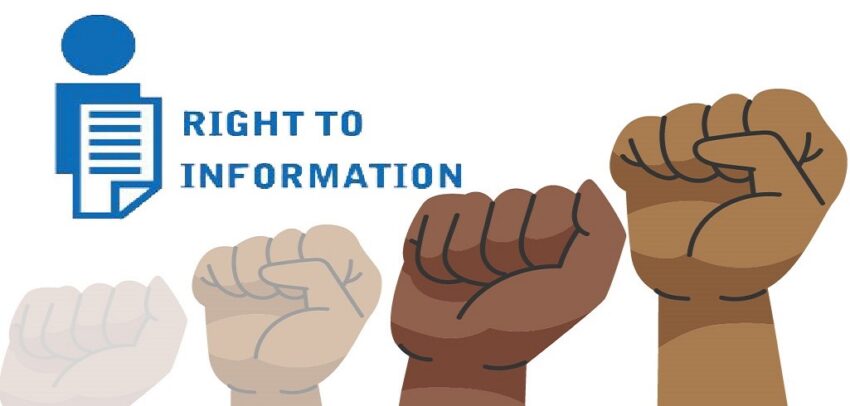
In Africa, Gaps Persist in Freedom of Information
While a growing number of African states have enacted Right-to Information laws – Zambia became the 28th in December – significant implementation gaps persist, Anne Okello, Sophie Sunderland and Joseph Asunka wrote Feb. 22 for Afro Barometer.
They cited scholars who “attribute the poor implementation of RTI laws in Africa to ‘restrictive clauses, lack of understanding of the laws by public officials and citizens, lack of political will and oversight mechanisms and the inability of institutions to comply with access to information law obligations.’
“In a case study of RTI laws in four African countries, the Africa Freedom of Information Centre (2021) found large inconsistencies in compliance with RTI provisions among public institutions in Nigeria and Zimbabwe and concluded that effective implementation is a function of political goodwill and the capacity and commitment of public institutions. . . .
“Across 39 countries surveyed in 2021/2023, a majority of Africans express support for public access to information such as local government budgets, local government bids and contracts, and even the salaries of public officials and teachers. But although demand for public information is high, few citizens think they could obtain such information. . . .”
- Article 19: The Right to Information Around the World (Sept. 28, 2017)
- Media Foundation For West Africa: How access to information laws influence investigative journalism in West Africa (Dec. 5)
Short Takes
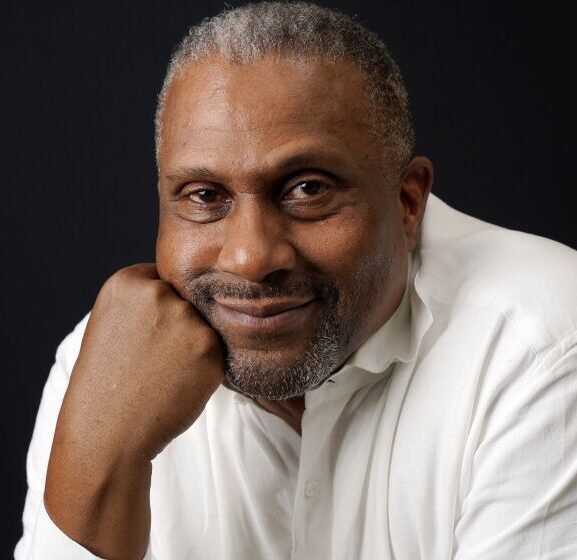 “The KBLA, Los Angeles-based ‘Tavis Smiley Show’ (pictured) is set to add four new markets to its national syndication effort. SmileyAudioMedia, Inc says that over the next couple of weeks, the show will launch on City College of New York’s WHCR-FM, New York; Urban One’s WOL-AM, Washington, DC; Courier Communications’ WNOV-AM, Milwaukee; and Minority Communications’ KJMC-FM, Des Moines,” Talkers magazine reported Wednesday.
“The KBLA, Los Angeles-based ‘Tavis Smiley Show’ (pictured) is set to add four new markets to its national syndication effort. SmileyAudioMedia, Inc says that over the next couple of weeks, the show will launch on City College of New York’s WHCR-FM, New York; Urban One’s WOL-AM, Washington, DC; Courier Communications’ WNOV-AM, Milwaukee; and Minority Communications’ KJMC-FM, Des Moines,” Talkers magazine reported Wednesday.
- “Essence Magazine’s parent company is in talks to acquire Vice Media’s women’s lifestyle site Refinery29, a deal that could help the Black-owned media brand expand its digital profile and reach more young women,” Alexandra Bruell reported Wednesday for the Wall Street Journal. “The price being discussed couldn’t be learned but Essence would likely pay a fraction of the $400 million Vice paid in cash and stock when it bought Refinery29 in 2019, according to people familiar with the situation. . . .”
 At NBC, “Catherine Kim (pictured) has been promoted to executive vice president of news and will oversee the integration of coverage across all of the network’s platforms,” Ted Johnson reported Wednesday for Deadline. “That includes ‘leveraging the storied brands of the News Group’s portfolio, including partnering with CNBC, Telemundo and Local,’ Rebecca Blumenstein, president of editorial for NBC News, wrote in a memo to staffers.”
At NBC, “Catherine Kim (pictured) has been promoted to executive vice president of news and will oversee the integration of coverage across all of the network’s platforms,” Ted Johnson reported Wednesday for Deadline. “That includes ‘leveraging the storied brands of the News Group’s portfolio, including partnering with CNBC, Telemundo and Local,’ Rebecca Blumenstein, president of editorial for NBC News, wrote in a memo to staffers.”
- “ABC13 Chief Forecaster David Tillman is receiving recognition for being part of just 2% of Black meteorologists across the country, KTRK-TV in Houston reported Thursday. “While the field is growing for Black people, there’s still work to do. The National Association of Black Journalists found there were 126 Black meteorologists employed by TV stations in 2023. . . . Tillman said he knew there was a path for him because of the pioneering Black men and woman he saw forecasting the weather on TV when he was growing up in St. Louis. . . .”
 “Cassandra Singfield (pictured) was named publisher and sales director of the Post and Courier North Augusta/The Star on Jan. 1, breaking the newspaper out from under the Aiken Standard and highlighting North Augusta as its own market,” Elizabeth Hustad wrote Wednesday for the South Carolina news organization. “Singfield has been with Evening Post Publishing for almost seven years, most recently as Human Resources manager for both the Aiken Standard and the Post and Courier North Augusta. ‘In those seven years, I never wore just one hat,’ she said. Singfield has also managed production operations for the Standard and, for three months in 2022, served as interim publisher. . . .”
“Cassandra Singfield (pictured) was named publisher and sales director of the Post and Courier North Augusta/The Star on Jan. 1, breaking the newspaper out from under the Aiken Standard and highlighting North Augusta as its own market,” Elizabeth Hustad wrote Wednesday for the South Carolina news organization. “Singfield has been with Evening Post Publishing for almost seven years, most recently as Human Resources manager for both the Aiken Standard and the Post and Courier North Augusta. ‘In those seven years, I never wore just one hat,’ she said. Singfield has also managed production operations for the Standard and, for three months in 2022, served as interim publisher. . . .”
- “More than three years after nationwide protests over racial inequality led publishers to promise they would reshape their overwhelmingly white industry, a survey showed they made little progress toward creating a more diverse publishing work force,” Alexandra Alter and Elizabeth A. Harris reported Wednesday for The New York Times. “White workers made up 72.5 percent of the book business in 2023, according to a new report from the publishing house Lee & Low. That marks a slight decrease from 2019, when the survey found that white people accounted for 76 percent of publishing industry employees. In 2015, that figure was 79 percent. . . .”
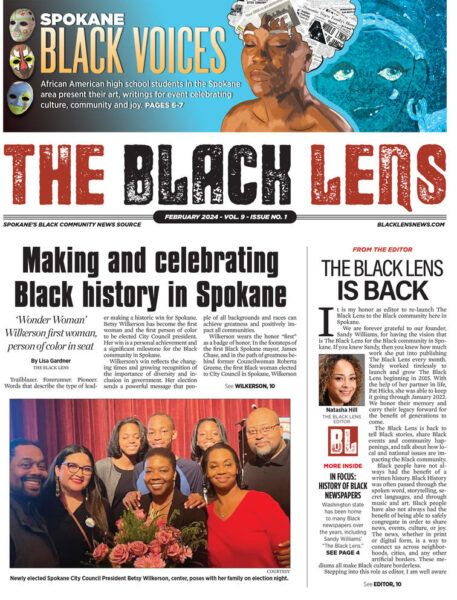
- “Black History Month in Spokane will be memorable this year with the relaunch of the publication that had documented the events and happenings of the city’s Black community for nearly a decade,” Mai Hoang reported Tuesday for Crosscut in Spokane, Wash. “After nearly a two-year hiatus, the latest edition of The Black Lens showed up inside The Spokesman-Review and in Black-owned small businesses and churches. The future of the community newspaper had looked uncertain when founder and community activist Sandy Williams died in September 2022. The publication had already been on hiatus since January of that year. But a collaborative effort between Williams’ family, members of Spokane’s Black communities and Spokesman-Review journalists, plus an outpouring of support from businesses and community members, gave the publication new life. . . . “
- “Here’s an idea to steal and adapt: Instead of simply extending the opportunity to be part of the opinion section, why not meet with folks and give them the tools to join the conversation?” Allie Ginwala, audience engagement editor for the Concord (N.H.) Monitor, wrote for Better News. She described the paper’s writer’s workshop. “We always talk about how we want more voices, new voices, to be part of the opinion section, and we do share that message out often. But unfortunately, inviting participation doesn’t eliminate the barriers some people may face when trying to get engaged in civic dialogue. Putting pen to paper (or finger to keyboard) can often be a daunting task that begs the question, ‘Where do I even start?’ So, we decided to go one step further and give people the resources to start writing. . . .”
- “Drill rap is a form of hip-hop that started in Chicago in the 2000s before hitting the scene in New York,” the Columbia Journalism Review wrote Feb. 20. “The music’s subject matter has drawn the attention of city officials, who have accused it of encouraging violence. But people in the drill community say it’s reportage: what drill really does is describe the violence that its creators already experience. The Columbia Journalism Review spoke with drill rappers and producers who said drill should be seen as a living document of life in parts of the city that don’t usually make front-page news. . . .”
- “Senegalese reporter Ndèye Maty Niang, also known as Maty Sarr Niang, would have likely jumped at the chance to report on the political crisis gripping her country since the president postponed elections in early February,” Moussa Ngom and Jonathan Rozen reported Friday for the Committee to Protect Journalists. “But Niang can’t cover the news – she’s in a women’s prison awaiting trial. She’s not alone: Niang is one of at least five journalists jailed since last year in Senegal in connection with their work. It’s the highest number ever recorded in the country since CPJ began keeping track in 1992 with its annual December 1 prison census. . . .”
- “Authorities in the Democratic Republic of Congo (DRC) must hold accountable the police officers who arrested and then assaulted journalist Masand Mafuta, and ensure his belongings are returned,” the Committee to Protect Journalists said Wednesday. “On February 23, at least six police officers in the capital, Kinshasa, detained Masand, general director of the Culture Congo news website, confiscated his camera, dictaphone, and telephone, as well as around US$300 in cash, and slapped him in the face, before releasing him the same day, according to media reports and Masand, who spoke with CPJ via messaging app. . . .”
- “The Committee to Protect Journalists said it “welcomed the Thursday release of French journalist Antoine Galindo, who was arrested in Ethiopia on February 22, and urged Ethiopian authorities to unconditionally release all other members of the press detained for their work. . . .”
- “A few years ago, recording a video vertically was unthinkable for audiovisual purists,” Katherine Pennacchio reported Feb. 20 for LatAm Journalism Review. “However, currently, all the main social networks such as Instagram, Facebook, Snapchat, Twitter, TikTok and YouTube have a specific space for vertical video, the format made for mobile. The main digital media in Latin America have not been left behind. Outlets such as El Universal and Excelsior from Mexico, Metrópoles from Brazil, La Nación from Argentina and El Tiempo from Colombia, which have millions of subscribers on YouTube, publish several short videos a day adding up to thousands of views. . . .”
To subscribe at no cost, please send an email to journal-isms+subscribe@groups.io and say who you are.
Facebook users: “Like” “Richard Prince’s Journal-isms” on Facebook.
Follow Richard Prince on Twitter @princeeditor
Richard Prince’s Journal-isms originates from Washington. It began in print before most of us knew what the internet was, and it would like to be referred to as a “column.” Any views expressed in the column are those of the person or organization quoted and not those of any other entity. Send tips, comments and concerns to Richard Prince at journal-isms+owner@
View previous columns (after Feb. 13, 2016).
View previous columns (before Feb. 13, 2016)
- Diversity’s Greatest Hits, 2018 (Jan. 4, 2019)
- Book Notes: Is Taking a Knee Really All That? (Dec. 20, 2018)
- Book Notes: Challenging ’45’ and Proudly Telling the Story (Dec. 18, 2018)
- Book Notes: Get Down With the Legends! (Dec. 11, 2018)
- Journalist Richard Prince w/Joe Madison (Sirius XM, April 18, 2018) (podcast)
- Richard Prince (journalist) (Wikipedia entry)
- February 2018 Podcast: Richard “Dick” Prince on the need for newsroom diversity (Gabriel Greschler, Student Press Law Center, Feb. 26, 2018)
- Diversity’s Greatest Hits, 2017 — Where Will They Take Us in the Year Ahead?
- Book Notes: Best Sellers, Uncovered Treasures, Overlooked History (Dec. 19, 2017)
- An advocate for diversity in the media is still pressing for representation, (Courtland Milloy, Washington Post, Nov. 28, 2017)
- Morgan Global Journalism Review: Journal-isms Journeys On (Aug. 31, 2017)
- Diversity’s Greatest Hits, 2016
- Book Notes: 16 Writers Dish About ‘Chelle,’ the First Lady
- Book Notes: From Coretta to Barack, and in Search of the Godfather
- Journal-isms’ Richard Prince Wants Your Ideas (FishbowlDC, Feb. 26, 2016)
- “JOURNAL-ISMS” IS LATEST TO BEAR BRUNT OF INDUSTRY’S ECONOMIC WOES (Feb. 19, 2016)
- Richard Prince with Charlayne Hunter-Gault, “PBS NewsHour,” “What stagnant diversity means for America’s newsrooms” (Dec. 15, 2015)
- Book Notes: Journalists Follow Their Passions
- Book Notes: Journalists Who Rocked Their World
- Book Notes: Hands Up! Read This!
- Book Notes: New Cosby Bio Looks Like a Best-Seller
- Journo-diversity advocate turns attention to Ezra Klein project (Erik Wemple, Washington Post, March 5, 2014)

